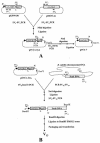Display of biologically functional insecticidal toxin on the surface of lambda phage
- PMID: 15528522
- PMCID: PMC525175
- DOI: 10.1128/AEM.70.11.6587-6594.2004
Display of biologically functional insecticidal toxin on the surface of lambda phage
Abstract
The successful use of Bacillus thuringiensis insecticidal toxins to control agricultural pests could be undermined by the evolution of insect resistance. Under selection pressure in the laboratory, a number of insects have gained resistance to the toxins, and several cases of resistance in the diamondback moth have been reported from the field. The use of protein engineering to develop novel toxins active against resistant insects could offer a solution to this problem. The display of proteins on the surface of phages has been shown to be a powerful technology to search for proteins with new characteristics from combinatorial libraries. However, this potential of phage display to develop Cry toxins with new binding properties and new target specificities has hitherto not been realized because of the failure of displayed Cry toxins to bind their natural receptors. In this work we describe the construction of a display system in which the Cry1Ac toxin is fused to the amino terminus of the capsid protein D of bacteriophage lambda. The resultant phage was viable and infectious, and the displayed toxin interacted successfully with its natural receptor.
Figures





Similar articles
-
Phage display of a biologically active Bacillus thuringiensis toxin.Appl Environ Microbiol. 1998 Aug;64(8):2995-3003. doi: 10.1128/AEM.64.8.2995-3003.1998. Appl Environ Microbiol. 1998. PMID: 9687463 Free PMC article.
-
Phage display of Bacillus thuringiensis CryIA(a) insecticidal toxin.FEBS Lett. 1997 Jul 7;411(1):27-31. doi: 10.1016/s0014-5793(97)00647-9. FEBS Lett. 1997. PMID: 9247136
-
Employing phage display to study the mode of action of Bacillus thuringiensis Cry toxins.Peptides. 2008 Feb;29(2):324-9. doi: 10.1016/j.peptides.2007.07.035. Epub 2007 Dec 14. Peptides. 2008. PMID: 18226423 Free PMC article. Review.
-
N-acetylgalactosamine on the putative insect receptor aminopeptidase N is recognised by a site on the domain III lectin-like fold of a Bacillus thuringiensis insecticidal toxin.J Mol Biol. 1999 Apr 16;287(5):1011-22. doi: 10.1006/jmbi.1999.2649. J Mol Biol. 1999. PMID: 10222207
-
Role of receptor interaction in the mode of action of insecticidal Cry and Cyt toxins produced by Bacillus thuringiensis.Peptides. 2007 Jan;28(1):169-73. doi: 10.1016/j.peptides.2006.06.013. Epub 2006 Dec 4. Peptides. 2007. PMID: 17145116 Review.
Cited by
-
Construction and analysis of a genetically tuneable lytic phage display system.Appl Microbiol Biotechnol. 2013 Sep;97(17):7791-804. doi: 10.1007/s00253-013-4898-6. Epub 2013 May 3. Appl Microbiol Biotechnol. 2013. PMID: 23640362 Free PMC article.
-
Affinity maturation of Cry1Aa toxin to the Bombyx mori cadherin-like receptor by directed evolution.Mol Biotechnol. 2013 Jul;54(3):888-99. doi: 10.1007/s12033-012-9638-0. Mol Biotechnol. 2013. PMID: 23247992
-
Investigating the properties of Bacillus thuringiensis Cry proteins with novel loop replacements created using combinatorial molecular biology.Appl Environ Microbiol. 2008 Jun;74(11):3497-511. doi: 10.1128/AEM.02844-07. Epub 2008 Apr 11. Appl Environ Microbiol. 2008. PMID: 18408065 Free PMC article.
-
A Tribute to a Bacillus thuringiensis Master: Professor David J. Ellar.Toxins (Basel). 2020 Dec 3;12(12):764. doi: 10.3390/toxins12120764. Toxins (Basel). 2020. PMID: 33287128 Free PMC article.
-
Improving Cry8Ka toxin activity towards the cotton boll weevil (Anthonomus grandis).BMC Biotechnol. 2011 Sep 9;11:85. doi: 10.1186/1472-6750-11-85. BMC Biotechnol. 2011. PMID: 21906288 Free PMC article.
References
-
- Bell, R. A., and F. G. Joachim. 1976. Techniques for rearing laboratory colonies of tobacco hornworms and pink bollworms. Ann. Entomol. Soc. Am. 69:365-373.
-
- Blattner, F. R., A. E. Blechl, K. Denniston-Thompson, H. E. Faber, J. E. Richards, J. L. Slightom, P. W. Tucker, and O. Smithies. 1978. Cloning human fetal gamma globin and mouse alpha-type globin DNA: preparation and screening of shotgun collections. Science 202:1279-1284. - PubMed
-
- Bradford, M. M. 1976. A rapid and sensitive method for the quantitation of microgram quantities of protein utilizing the principle of protein-dye binding. Anal. Biochem. 72:248-254. - PubMed
-
- Burton, S. L., D. J. Ellar, J. Li, and D. J. Derbyshire. 1999. N-acetylgalactosamine on the putative insect receptor aminopeptidase-N is recognised by a site on the domain III lectin-like fold of a Bacillus thuringiensis insecticidal toxin. J. Mol. Biol. 287:1011-1022. - PubMed
-
- Carroll, J., and D. J. Ellar. 1993. An analysis of Bacillus thuringiensis δ-endotoxin action on insect midgut-membrane permeability using a light scattering assay. Eur. J. Biochem. 214:771-778. - PubMed
Publication types
MeSH terms
Substances
LinkOut - more resources
Full Text Sources
Other Literature Sources

